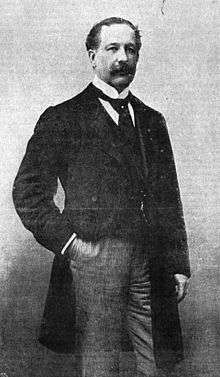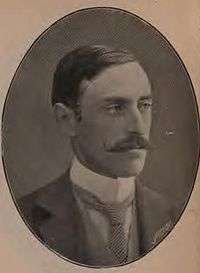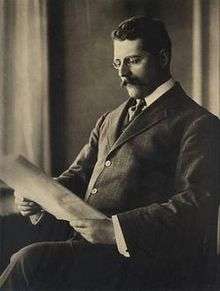Liverpool Exchange (UK Parliament constituency)
| Liverpool Exchange | |
|---|---|
|
Former Borough constituency for the House of Commons | |
| 1885–1974 | |
| Number of members | One |
| Replaced by | Liverpool Scotland Exchange |
| Created from | Liverpool |
Liverpool Exchange was a borough constituency within the city of Liverpool in England, centred on Liverpool Exchange railway station. It returned one Member of Parliament (MP) to the House of Commons of the Parliament of the United Kingdom, elected by the first past the post system.
The constituency was created under the Redistribution of Seats Act 1885 for the 1885 general election. It was abolished for the February 1974 election, when it was merged with Liverpool Scotland to form Liverpool Scotland Exchange.
Boundaries
The constituency covered the centre of the city of Liverpool, bordering on the River Mersey. It included the commercial area of the city, as well as poorer housing. It originally consisted of the wards of Vauxhall, St Ann Street, Lime Street, Exchange, and St Paul's.
1885-1918
The Exchange Ward, with a significant Conservative business vote, was combined with the St Anne's and Vauxhall wards (which were more Liberal and contained a substantial Irish vote).
The Scotland division, to the north of this seat, was more heavily Irish and returned an Irish Nationalist MP. Exchange was a Liberal/Conservative and Allies marginal constituency and its elections were influenced by what guidance the electors were given by Nationalist leaders.
1918-1950
In this period the seat was defined as comprising the Abercromby, Castle Street, Exchange, Great George, St Anne's, St Peter's, and Vauxhall wards.
In this era the area was represented by Conservative Members of Parliament, until the Labour Party captured the seat in 1945.
1950-1955
Brunswick, and Granby wards were added to those previously in the seat.
1955-1974
The constituency comprised Abercromby, Central, Granby, Low Hill, and St James wards.
In the redistribution which took effect in 1974, this seat disappeared. However the successor constituency was named Liverpool Scotland Exchange, combining as it did the central and northern riverside parts of the city.
Members of Parliament
Election results
Elections in the 1880s

| Party | Candidate | Votes | % | ± | |
|---|---|---|---|---|---|
| Conservative | Laurence Richardson Baily | 2,964 | 50.2 | n/a | |
| Liberal | William Henry O'Shea | 2,909 | 49.2 | n/a | |
| Independent Liberal | Thomas English Stephens | 36 | 0.6 | n/a | |
| Majority | 55 | 1.0 | n/a | ||
| Turnout | 5,909 | 72.3 | n/a | ||
| Conservative win (new seat) | |||||
| Party | Candidate | Votes | % | ± | |
|---|---|---|---|---|---|
| Liberal | David Duncan | 2,920 | 51.5 | +2.3 | |
| Conservative | Laurence Richardson Baily | 2,750 | 48.5 | -1.7 | |
| Majority | 170 | 3.0 | 4.0 | ||
| Turnout | 5,670 | 69.4 | -2.9 | ||
| Liberal gain from Conservative | Swing | +2.0 | |||

| Party | Candidate | Votes | % | ± | |
|---|---|---|---|---|---|
| Liberal | Ralph Neville | 3,217 | 50.1 | -1.4 | |
| Liberal Unionist | George Goschen | 3,210 | 49.9 | +1.4 | |
| Majority | 7 | 0.2 | -2.8 | ||
| Turnout | 6,427 | 81.2 | +11.8 | ||
| Liberal hold | Swing | -1.4 | |||
Elections in the 1890s

| Party | Candidate | Votes | % | ± | |
|---|---|---|---|---|---|
| Liberal | Ralph Neville | 2,721 | 50.6 | +0.5 | |
| Liberal Unionist | John Charles Bigham | 2,655 | 49.4 | -0.5 | |
| Majority | 66 | 1.2 | +1.0 | ||
| Turnout | 5,376 | 71.5 | -9.7 | ||
| Liberal hold | Swing | +0.5 | |||
| Party | Candidate | Votes | % | ± | |
|---|---|---|---|---|---|
| Liberal Unionist | John Charles Bigham | 2,884 | 52.3 | +2.9 | |
| Liberal | William Benjamin Bowring | 2,630 | 47.7 | -2.9 | |
| Majority | 254 | 4.6 | 5.8 | ||
| Turnout | 5,514 | 78.1 | +6.6 | ||
| Liberal Unionist gain from Liberal | Swing | +2.9 | |||

| Party | Candidate | Votes | % | ± | |
|---|---|---|---|---|---|
| Liberal Unionist | Charles McArthur | 2,711 | 50.5 | -1.8 | |
| Liberal | Russell Rea | 2,657 | 49.5 | +1.8 | |
| Majority | 54 | 1.0 | -3.6 | ||
| Turnout | 5,368 | 76.0 | -2.1 | ||
| Liberal Unionist hold | Swing | -1.8 | |||
Elections in the 1900s

| Party | Candidate | Votes | % | ± | |
|---|---|---|---|---|---|
| Liberal Unionist | Charles McArthur | 2,811 | 65.0 | +14.5 | |
| Liberal | Frederick William Verney | 1,514 | 35.0 | -14.5 | |
| Majority | 1,297 | 30.0 | +29.0 | ||
| Turnout | 5,325 | 64.4 | -11.6 | ||
| Liberal Unionist hold | Swing | +14.5 | |||

| Party | Candidate | Votes | % | ± | |
|---|---|---|---|---|---|
| Liberal | Richard Robert Cherry | 2,291 | 51.4 | +16.4 | |
| Liberal Unionist | Charles McArthur | 2,170 | 48.6 | -16.4 | |
| Majority | 121 | 2.8 | 32.8 | ||
| Turnout | 4,461 | 75.7 | +11.3 | ||
| Liberal gain from Liberal Unionist | Swing | +16.4 | |||
Elections in the 1910s

| Party | Candidate | Votes | % | ± | |
|---|---|---|---|---|---|
| Liberal | Max Muspratt | 2,392 | 51.7 | +0.3 | |
| Conservative | Leslie Frederic Scott | 2,231 | 48.3 | -0.3 | |
| Majority | 161 | 3.4 | +0.6 | ||
| Turnout | 82.5 | +6.8 | |||
| Liberal hold | Swing | ||||
| Party | Candidate | Votes | % | ± | |
|---|---|---|---|---|---|
| Conservative | Leslie Frederic Scott | 2,330 | 51.6 | +3.3 | |
| Liberal | Max Muspratt | 2,187 | 48.4 | -3.3 | |
| Majority | 143 | 3.2 | 6.6 | ||
| Turnout | 4,517 | 80.6 | -1.9 | ||
| Conservative gain from Liberal | Swing | +3.3 | |||
General Election 1914/15:
Another General Election was required to take place before the end of 1915. The political parties had been making preparations for an election to take place and by the July 1914, the following candidates had been selected;
- Unionist: Leslie Frederic Scott
- Liberal:
| Party | Candidate | Votes | % | ± | |
|---|---|---|---|---|---|
| Unionist | 10,286 | 55.6 | +4.0 | ||
| Irish Nationalist | Austin Harford | 8,225 | 44.4 | n/a | |
| Majority | 2,061 | 11.2 | +8.0 | ||
| Turnout | 18,511 | 52.0 | -28.6 | ||
| Unionist hold | Swing | n/a | |||
- endorsed by Coalition Government
Elections in the 1920s
| Party | Candidate | Votes | % | ± | |
|---|---|---|---|---|---|
| Unionist | Leslie Frederic Scott | unopposed | n/a | n/a | |
| Unionist hold | Swing | n/a | |||
| Party | Candidate | Votes | % | ± | |
|---|---|---|---|---|---|
| Unionist | Leslie Frederic Scott | 15,650 | 55.4 | n/a | |
| Irish Nationalist | Joseph Devlin | 12,614 | 44.6 | n/a | |
| Majority | 3,036 | 10.8 | n/a | ||
| Turnout | 28,264 | 74.8 | n/a | ||
| Unionist hold | Swing | n/a | |||
| Party | Candidate | Votes | % | ± | |
|---|---|---|---|---|---|
| Unionist | Leslie Frederic Scott | 10,551 | 50.5 | -4.9 | |
| Irish Nationalist | William Grogan | 10,322 | 49.5 | +4.9 | |
| Majority | 229 | 1.0 | -9.8 | ||
| Turnout | 51.9 | -22.9 | |||
| Unionist hold | Swing | -4.9 | |||
| Party | Candidate | Votes | % | ± | |
|---|---|---|---|---|---|
| Unionist | Leslie Frederic Scott | unopposed | n/a | n/a | |
| Unionist hold | Swing | n/a | |||
| Party | Candidate | Votes | % | ± | |
|---|---|---|---|---|---|
| Unionist | Sir James Philip Reynolds | 17,179 | 50.3 | n/a | |
| Labour | William Albert Robinson | 16,970 | 49.7 | n/a | |
| Majority | 209 | 0.6 | n/a | ||
| Turnout | 34,149 | 65.9 | n/a | ||
| Unionist hold | Swing | n/a | |||
Elections in the 1930s
| Party | Candidate | Votes | % | ± | |
|---|---|---|---|---|---|
| Conservative | Sir James Philip Reynolds | 24,008 | 68.8 | +18.5 | |
| Labour | T. McLean | 10,894 | 31.2 | -18.5 | |
| Majority | 13,144 | 37.6 | +37.0 | ||
| Turnout | 69.0 | +3.1 | |||
| Conservative hold | Swing | +18.5 | |||
| Party | Candidate | Votes | % | ± | |
|---|---|---|---|---|---|
| Conservative | John Joseph Shute | 15,198 | 55.0 | -13.8 | |
| Labour | Samuel Sydney Silverman | 12,412 | 45.0 | +13.8 | |
| Majority | 2,786 | 10.0 | -26.6 | ||
| Turnout | 27,610 | 55.2 | -13.8 | ||
| Conservative hold | Swing | -13.8 | |||
| Party | Candidate | Votes | % | ± | |
|---|---|---|---|---|---|
| Conservative | Sir John Joseph Shute | 17,439 | 57.2 | +2.2 | |
| Labour | S. Mahon | 13,027 | 42.8 | -2.2 | |
| Majority | 4,412 | 14.4 | +4.4 | ||
| Turnout | 65.7 | +10.5 | |||
| Conservative hold | Swing | +2.2 | |||
General Election 1939/40
Another General Election was required to take place before the end of 1940. The political parties had been making preparations for an election to take place and by the Autumn of 1939, the following candidates had been selected;
- Conservative: Sir John Joseph Shute
- Labour:
Elections in the 1940s
| Party | Candidate | Votes | % | ± | |
|---|---|---|---|---|---|
| Labour | Elizabeth Margaret Braddock | 8,494 | 52.0 | +9.2 | |
| Conservative | Sir John Joseph Shute | 7,829 | 48.0 | -9.2 | |
| Majority | 665 | 4.0 | 18.4 | ||
| Turnout | 16,323 | 60.9 | -4.8 | ||
| Labour gain from Conservative | Swing | +9.2 | |||
Elections in the 1950s
| Party | Candidate | Votes | % | ± | |
|---|---|---|---|---|---|
| Labour | Elizabeth Margaret Braddock | 19,492 | 57.3 | +5.3 | |
| Conservative | Sir John Francis Roskell Reynolds | 14,150 | 41.6 | −6.4 | |
| Independent Labour | A.G. Cleather | 381 | 1.1 | n/a | |
| Majority | 5,342 | 15.7 | |||
| Turnout | 34,023 | 72.8 | +11.9 | ||
| Labour hold | Swing | +5.9 | |||
| Party | Candidate | Votes | % | ± | |
|---|---|---|---|---|---|
| Labour | Elizabeth Margaret Braddock | 19,887 | 60.4 | +3.1 | |
| Conservative | John O. Tiernan | 13,052 | 39.6 | −2.0 | |
| Majority | 6,835 | 20.7 | |||
| Turnout | 32,939 | 69.2 | |||
| Labour hold | Swing | ||||
| Party | Candidate | Votes | % | ± | |
|---|---|---|---|---|---|
| Labour | Elizabeth Margaret Braddock | 19,457 | 56.1 | −4.3 | |
| Conservative | Mrs. Anne Elizabeth Papworth | 12,271 | 35.4 | −4.2 | |
| Independent Labour | Lawrence Murphy | 2,928 | 8.4 | N/A | |
| Majority | 7,186 | 20.7 | |||
| Turnout | 34,656 | 62.5 | −6.7 | ||
| Labour hold | Swing | +0.0 | |||
| Party | Candidate | Votes | % | ± | |
|---|---|---|---|---|---|
| Labour | Elizabeth Margaret Braddock | 18,916 | 61.3 | +5.2 | |
| Conservative | Tom Beattie-Edwards | 11,945 | 38.7 | +3.3 | |
| Majority | 6,971 | 22.6 | |||
| Turnout | 30,861 | 60.5 | −2.0 | ||
| Labour hold | Swing | +1.0 | |||
Elections in the 1960s
| Party | Candidate | Votes | % | ± | |
|---|---|---|---|---|---|
| Labour | Elizabeth Margaret Braddock | 16,985 | 70.1 | +8.8 | |
| Conservative | Vincent Burke | 7,239 | 29.9 | −8.8 | |
| Majority | 9,746 | 40.2 | |||
| Turnout | 24,224 | 54.4 | −6.1 | ||
| Labour hold | Swing | +8.8 | |||
| Party | Candidate | Votes | % | ± | |
|---|---|---|---|---|---|
| Labour | Elizabeth Margaret Braddock | 15,089 | 73.7 | +3.6 | |
| Conservative | Barry Vincent Groombridge | 5,372 | 26.3 | −3.6 | |
| Majority | 9,717 | 47.5 | |||
| Turnout | 20,461 | 50.7 | −3.7 | ||
| Labour hold | Swing | +3.6 | |||
Elections in the 1970s
| Party | Candidate | Votes | % | ± | |
|---|---|---|---|---|---|
| Labour | Robert Parry | 12,995 | 70.6 | −3.1 | |
| Conservative | Anthony G. Phillips | 4,638 | 25.2 | −1.1 | |
| Communist | Roger O'Hara | 775 | 4.2 | n/a | |
| Majority | 8,357 | 45.4 | |||
| Turnout | 18,408 | 53.4 | +2.7 | ||
| Labour hold | Swing | −1.0 | |||
References
- ↑ Leigh Rayment's Historical List of MPs – Constituencies beginning with "E" (part 2)
- ↑ Craig, F. W. S. (1983) [1989]. British parliamentary election results 1885–1918 (2nd ed.). Chichester: Parliamentary Research Services. p. 141. ISBN 0-900178-27-2.
- ↑ Craig, F. W. S. (1983) [1969]. British parliamentary election results 1918–1949 (3rd ed.). Chichester: Parliamentary Research Services. p. 176. ISBN 0-900178-06-X.
- 1 2 3 4 5 6 7 8 9 British Parliamentary Election Results 1885-1918, FWS Craig
- 1 2 3 4 5 6 7 The Liberal Year Book, 1907
- ↑ Debrett's House of Commons & Judicial Bench, 1886
- ↑ The Constitutional Year Book, 1904, published by Conservative Central Office, page 170 (194 in web page)
- ↑ Debrett's House of Commons & Judicial Bench, 1901
- ↑ Debrett's House of Commons & Judicial Bench, 1901
- ↑ Debrett's House of Commons & Judicial Bench, 1901
- ↑ Debrett's House of Commons & Judicial Bench, 1916
- ↑ Debrett's House of Commons & Judicial Bench, 1916
- 1 2 3 4 5 6 7 8 9 10 British Parliamentary Election Results 1918-1949, FWS Craig
- 1 2 3 4 5 6 7 British Parliamentary Election Results 1950-1973, FWS Craig
- 1 2 3 4 5 6 7 The Times House of Commons, 1950-70